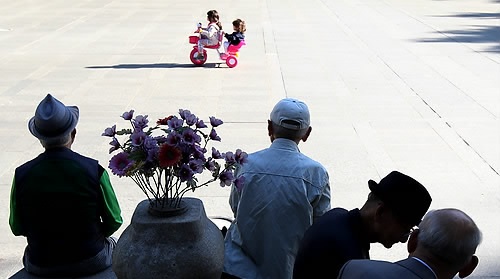- California Assembly OKs highest minimum wage in nation
- S. Korea unveils first graphic cigarette warnings
- US joins with South Korea, Japan in bid to deter North Korea
- LPGA golfer Chun In-gee finally back in action
- S. Korea won’t be top seed in final World Cup qualification round
- US men’s soccer misses 2nd straight Olympics
- US back on track in qualifying with 4-0 win over Guatemala
- High-intensity workout injuries spawn cottage industry
- CDC expands range of Zika mosquitoes into parts of Northeast
- Who knew? ‘The Walking Dead’ is helping families connect
Data shows rapid pace of aging in S. Korea
SEJONG (Yonhap) — South Korea is on the threshold of becoming an aged society, with the share of senior citizens aged 65 or older in the nation’s population topping 13 percent last year, data showed Wednesday.
According to the data by Statistics Korea, 13.1 percent of South Korea’s 50.62 million population were 65 or older in 2015, which is slightly higher than the 12.7 percent tallied a year earlier and much higher than the 3.8 percent in 1980.
Generally, a nation is defined as an “aged society,” if more than 14 percent of the population are 65 or older.
Officials and experts have warned that the aging population, coupled with the low birthrate, would pose a serious threat to the nation’s economy as it could lead to fewer workers and increased spending on health and welfare.
The statistics agency’s data also showed that the number of people tying the knot fell 5.3 percent on-year to 305,507 in 2014, with those getting a divorce standing at 115,510, nearly unchanged from a year earlier.
The outlook for South Korea’s rapid aging is not bright.
It took only 10 years for the nation to surpass the 13 percent share of senior citizens from 9.1 percent in 2005.
The agency expects that percentage to further increase to 24.3 percent by 2030, 32.3 percent by 2040 and 40.1 percent by 2060.
Asia’s fourth-largest economy already became an “aging society” in 2000, when the ratio topped 7 percent.
The medium age of the country’s population came in at 40.8 years old last year, and will likely move up to 52.6 in 2040.
Against this backdrop, every 100 working-age people supported the livelihoods of 17.9 senior citizens last year, with this number expected to triple to 100 people providing for 57.2 senior citizens in 2040.
















